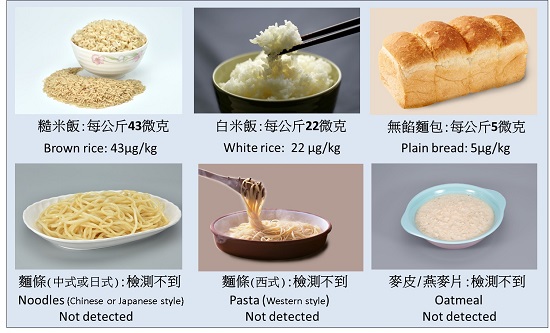
Food Safety Focus (132nd Issue, July 2017 ) – Food Safety Platform
Metallic Contaminants of Major Public Health Concern
Reported by Ms. Janny MA, Scientific Officer,
Risk Assessment Section,
Centre for Food Safety
Metals are ubiquitous in the environment and may contaminate our food. Among the metallic contaminants which may be found in our food, four of them, namely arsenic , cadmium , lead and mercury are identified as of major public health concern by the World Health Organization. In this article, we are going to explore ways to reduce their exposures from the respective major food contributors of the population as revealed from the local Total Diet Study.
Arsenic in Rice
Arsenic is a metalloid that occurs in inorganic and organic forms. The International Agency for Research on Cancer (IARC) has concluded that arsenic and inorganic arsenic compounds are carcinogenic to humans (Group 1).
Arsenic may be present, due to absorption through soil and water, in various foods. Rice in particular can take up more arsenic than other grains while inorganic arsenic is considered the significant toxic form of arsenic in rice. Polished (white) rice contains less inorganic arsenic than husked (brown) rice as polishing can remove bran layer which contains most of the inorganic arsenic. However, there are also benefits associated with the consumption of brown rice e.g. high content of dietary fibre.

Figure 2. Average level of inorganic arsenic in various cereals and their products as revealed in the local Total Diet Study .
As a staple food, rice is a major contributor of the dietary exposure to inorganic arsenic, in which cooked white rice alone accounted for about 45% of total exposure in the local population. Studies have indicated that cooking rice with large amounts of water (from six to 10 parts of water to one part of rice) followed by discarding excess water can reduce inorganic arsenic in rice. There are also studies showing that washing rice before cooking, even though it may also wash off some nutrients like iron, niacin, thiamine and folate, can also reduce inorganic arsenic in white rice. To reduce inorganic arsenic exposure from diet, consumers may also consider choosing more other cereals and their products e.g. noodles, oatmeal and bread, which generally contain lower levels of inorganic arsenic than rice (Figure 2).
Mercury in Fish
Mercury exists in several forms i.e. metallic, inorganic and organic. Methylmercury, an organic form of mercury, is more toxic than inorganic mercury. The primary health effect of methylmercury is impaired neurological development in foetuses, infants, and children. Methylmercury exposure in the womb, which can result from a mother’s diet, can adversely affect a baby’s growing brain and nervous system.
Fish is the major dietary source of methylmercury. Predatory fish are more likely to accumulate higher amount of methylmercury than non-predatory fish species. Women planning pregnancy, pregnant women and young children should therefore avoid eating certain types of fish which may contain high levels of methylmercury such as shark, swordfish, marlin, alfonsino and tuna.
However, consuming a variety of fish and maintaining a balanced diet are important as fish contains many essential nutrients for growth and development such as omega-3 fatty acids and high quality proteins. Women and young children in particular should include fish in their diets.
Lead in Vegetables
Lead contamination of food arises from various sources, including air and soil. Chronic exposure of lead may lead to reduction of intelligence quotient (IQ) in children and increase in blood pressure in adults respectively.
“Vegetables and their products” is the main dietary source of lead (30% of the total exposure) in the local population. Leafy vegetables are more vulnerable than non-leafy vegetables or root vegetables to deposition from airborne lead e.g. from industrial pollution.
Adequate amount of vegetable intake (daily intake of at least 3 servings; about 80g per serving) is an essential component of healthy eating. Wash vegetables, particularly leafy vegetables, thoroughly in water before cooking can remove a significant portion of lead-contaminated dust and soil that are deposited on the surfaces of the vegetables. In addition, maintaining a balanced diet with a variety of vegetables, not limited to leafy vegetables, can also avoid excessive exposure to lead from a small range of food items.
In the next issue…
We will continue with the remaining metallic contaminant – cadmium, which is also of major public health concern.


